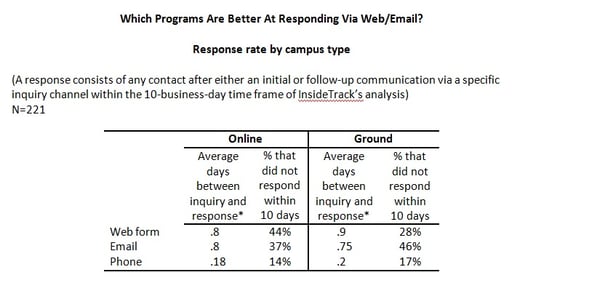Published on
Don't Spend Another Dollar On Adult Student Marketing Until You Read This
[caption id="attachment_3909" align="alignnone" width="600" caption="In order to make sure marketing dollars are being well-spent, higher education institutions need to test their own systems to see where improvements could be made. Photo by Bündnis 90."]
 [/caption] Marketing and admissions professionals at adult-serving higher education programs appreciate the importance of timely and comprehensive follow-up with prospective students. Busy, working adults aren’t likely to sit still waiting for a university to provide them with the information they need to make a decision. Also, marketing costs and competition are on the rise and making the most of every inquiry is critical to success. Nonetheless, recent research conducted by InsideTrack seems to indicate that many nontraditional programs are giving prospective students the silent treatment. Before spending another dollar on adult student marketing, ask yourself, “Are we making the most of the inquiries we already have?” Between 2010 and 2011, InsideTrack “secret shopped” 221 adult-serving degree programs to assess their inquiry handling processes for prospective students. Our research included for-profit programs, private and public non-profit programs, online and ground campuses, various academic program categories, and undergraduate and graduate degree programs. To best approximate the prospective student experience we engaged contractors similar in age and employment background to many non-traditional college degree seekers. Each team member inquired as a prospective student through three separate channels (web site form, email, and phone), using three different student personas. For each channel, researchers used a 10-point scale to measure response timeliness and the comprehensiveness of the information provided—resulting in a comprehensiveness score, a responsiveness score, and a combined overall score. The sub-analysis of program responsiveness reviewed here looked at two additional factors:
[/caption] Marketing and admissions professionals at adult-serving higher education programs appreciate the importance of timely and comprehensive follow-up with prospective students. Busy, working adults aren’t likely to sit still waiting for a university to provide them with the information they need to make a decision. Also, marketing costs and competition are on the rise and making the most of every inquiry is critical to success. Nonetheless, recent research conducted by InsideTrack seems to indicate that many nontraditional programs are giving prospective students the silent treatment. Before spending another dollar on adult student marketing, ask yourself, “Are we making the most of the inquiries we already have?” Between 2010 and 2011, InsideTrack “secret shopped” 221 adult-serving degree programs to assess their inquiry handling processes for prospective students. Our research included for-profit programs, private and public non-profit programs, online and ground campuses, various academic program categories, and undergraduate and graduate degree programs. To best approximate the prospective student experience we engaged contractors similar in age and employment background to many non-traditional college degree seekers. Each team member inquired as a prospective student through three separate channels (web site form, email, and phone), using three different student personas. For each channel, researchers used a 10-point scale to measure response timeliness and the comprehensiveness of the information provided—resulting in a comprehensiveness score, a responsiveness score, and a combined overall score. The sub-analysis of program responsiveness reviewed here looked at two additional factors:
 While many institutions responded to initial web-based (form or email) inquiries within less than a day, after that point it became increasingly unlikely that prospective students would receive a response at all, with about as many institutions responding to initial web-based inquiries within less than a day or a day as those not responding within the 10-day window of measurement our researchers employed. Meanwhile, most phone inquiries received a response within less than a day.
While many institutions responded to initial web-based (form or email) inquiries within less than a day, after that point it became increasingly unlikely that prospective students would receive a response at all, with about as many institutions responding to initial web-based inquiries within less than a day or a day as those not responding within the 10-day window of measurement our researchers employed. Meanwhile, most phone inquiries received a response within less than a day.
 Online and hybrid programs were 16 percentage points less likely to respond to web-based inquiries within 10 days than their ground campus counterparts, and when they did respond within the 10-day window, they were not significantly faster at doing so than ground programs. In summary, these findings point to opportunities to improve enrollment growth without additional marketing spending by simply responding to more of the inquiries that come in from prospective students. An initial report summarizing our findings, titled “A look at how colleges and universities respond to inquiries from prospective adult students” and available for download
here, showed that for-profit programs, online campuses, and Art/Design programs, responded in a more timely fashion and with more comprehensive information than their peers.
Originally posted on InsideTrack.
Online and hybrid programs were 16 percentage points less likely to respond to web-based inquiries within 10 days than their ground campus counterparts, and when they did respond within the 10-day window, they were not significantly faster at doing so than ground programs. In summary, these findings point to opportunities to improve enrollment growth without additional marketing spending by simply responding to more of the inquiries that come in from prospective students. An initial report summarizing our findings, titled “A look at how colleges and universities respond to inquiries from prospective adult students” and available for download
here, showed that for-profit programs, online campuses, and Art/Design programs, responded in a more timely fashion and with more comprehensive information than their peers.
Originally posted on InsideTrack.
 [/caption] Marketing and admissions professionals at adult-serving higher education programs appreciate the importance of timely and comprehensive follow-up with prospective students. Busy, working adults aren’t likely to sit still waiting for a university to provide them with the information they need to make a decision. Also, marketing costs and competition are on the rise and making the most of every inquiry is critical to success. Nonetheless, recent research conducted by InsideTrack seems to indicate that many nontraditional programs are giving prospective students the silent treatment. Before spending another dollar on adult student marketing, ask yourself, “Are we making the most of the inquiries we already have?” Between 2010 and 2011, InsideTrack “secret shopped” 221 adult-serving degree programs to assess their inquiry handling processes for prospective students. Our research included for-profit programs, private and public non-profit programs, online and ground campuses, various academic program categories, and undergraduate and graduate degree programs. To best approximate the prospective student experience we engaged contractors similar in age and employment background to many non-traditional college degree seekers. Each team member inquired as a prospective student through three separate channels (web site form, email, and phone), using three different student personas. For each channel, researchers used a 10-point scale to measure response timeliness and the comprehensiveness of the information provided—resulting in a comprehensiveness score, a responsiveness score, and a combined overall score. The sub-analysis of program responsiveness reviewed here looked at two additional factors:
[/caption] Marketing and admissions professionals at adult-serving higher education programs appreciate the importance of timely and comprehensive follow-up with prospective students. Busy, working adults aren’t likely to sit still waiting for a university to provide them with the information they need to make a decision. Also, marketing costs and competition are on the rise and making the most of every inquiry is critical to success. Nonetheless, recent research conducted by InsideTrack seems to indicate that many nontraditional programs are giving prospective students the silent treatment. Before spending another dollar on adult student marketing, ask yourself, “Are we making the most of the inquiries we already have?” Between 2010 and 2011, InsideTrack “secret shopped” 221 adult-serving degree programs to assess their inquiry handling processes for prospective students. Our research included for-profit programs, private and public non-profit programs, online and ground campuses, various academic program categories, and undergraduate and graduate degree programs. To best approximate the prospective student experience we engaged contractors similar in age and employment background to many non-traditional college degree seekers. Each team member inquired as a prospective student through three separate channels (web site form, email, and phone), using three different student personas. For each channel, researchers used a 10-point scale to measure response timeliness and the comprehensiveness of the information provided—resulting in a comprehensiveness score, a responsiveness score, and a combined overall score. The sub-analysis of program responsiveness reviewed here looked at two additional factors:
- How long it took for a program to respond to an initial inquiry
- How the inquiry response rate varied based on program type and inquiry channel
- More than one-third of web form and email inquiries we submitted did not receive responses within a 10-day window.
- Online programs were less likely to respond to web-form inquiries from prospective students than were their ground campus-based counterparts.
 While many institutions responded to initial web-based (form or email) inquiries within less than a day, after that point it became increasingly unlikely that prospective students would receive a response at all, with about as many institutions responding to initial web-based inquiries within less than a day or a day as those not responding within the 10-day window of measurement our researchers employed. Meanwhile, most phone inquiries received a response within less than a day.
While many institutions responded to initial web-based (form or email) inquiries within less than a day, after that point it became increasingly unlikely that prospective students would receive a response at all, with about as many institutions responding to initial web-based inquiries within less than a day or a day as those not responding within the 10-day window of measurement our researchers employed. Meanwhile, most phone inquiries received a response within less than a day.
 Online and hybrid programs were 16 percentage points less likely to respond to web-based inquiries within 10 days than their ground campus counterparts, and when they did respond within the 10-day window, they were not significantly faster at doing so than ground programs. In summary, these findings point to opportunities to improve enrollment growth without additional marketing spending by simply responding to more of the inquiries that come in from prospective students. An initial report summarizing our findings, titled “A look at how colleges and universities respond to inquiries from prospective adult students” and available for download
here, showed that for-profit programs, online campuses, and Art/Design programs, responded in a more timely fashion and with more comprehensive information than their peers.
Originally posted on InsideTrack.
Online and hybrid programs were 16 percentage points less likely to respond to web-based inquiries within 10 days than their ground campus counterparts, and when they did respond within the 10-day window, they were not significantly faster at doing so than ground programs. In summary, these findings point to opportunities to improve enrollment growth without additional marketing spending by simply responding to more of the inquiries that come in from prospective students. An initial report summarizing our findings, titled “A look at how colleges and universities respond to inquiries from prospective adult students” and available for download
here, showed that for-profit programs, online campuses, and Art/Design programs, responded in a more timely fashion and with more comprehensive information than their peers.
Originally posted on InsideTrack.
Author Perspective: Business



